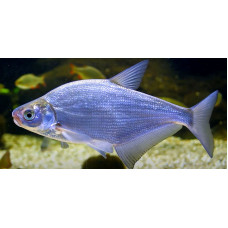Ballerus ballerus is a freshwater fish of the bream genus, carp family. It inhabits the basins of the Black, Azov, Caspian, Baltic and North Seas. It is widespread in the waters of Europe. Reaches 45 cm, weight 200-400 g, sometimes up to 800 g. The body is not as tall as that of bream. The mouth is terminal, directed upwards. River fish, but is found in flowing lakes, in river-type reservoirs. Matures at the age of 4-5 years. Spawns in spring. The eggs are sticky. Fecundity varies from 4 to 25 thousand eggs. In rivers it feeds on benthic organisms, in reservoirs mainly on zooplankton. It has a small commercial value.
Body tall, strongly compressed from sides, greatest body height four times body length. The snout is pointed. The mouth is terminal, oblique, directed upward. The dorsal fin is short but very high, with three stiff and 8-9 soft rays. The long anal fin has 3 hard and 36-43 soft rays. The scales are small, with 66-73 scales in the lateral line. Ballerus ballerus is similar in appearance to Ballerus sapa, but differs by its pointed snout and small scales. The caudal fin is notched, the lower lobe slightly longer than the upper one. The back is dark brown or grayish, sides golden brown (in young silver), belly yellowish, pectoral fins yellowish, the rest pale gray. During spawning, males have a spot on the side above the posterior part of the base of the anal fin. The maximum body length is 51 cm and weight is 1.53 kg. The record specimen was caught in Slovakia and weighed 2.2 kg. Usually adult Ballerus ballerus is less than 50 centimeters long and weighs up to 600 grams, but specimens weighing 1-1.2 kg have been encountered in the Volga and Ural. It has been noted that Ballerus ballerus grows better in reservoirs than in rivers. Fecundity depends on the size and age of Ballerus ballerus: the larger the size, the higher the fecundity. Females in the Kremenchug reservoir weighing about 300 grams had about 24 thousand eggs, females weighing 600 grams had more than twice as many. In the Kiev reservoir, four-year-old females were observed to have 25,000 eggs, while eight-year-old females had almost 100,000 eggs.
It belongs to lake-river fish. It is practically never found in non-flowing lakes and fast-flowing mountain rivers, preferring quiet riverbeds in large rivers, as well as flowing lakes located in river channels. The range of Ballerus ballerus is much smaller than that of bream. It is found in the rivers of most of Central and Eastern Europe, Sweden, and European Russia, not reaching Ladoga and Onega lakes and the rivers of the White Sea basin and the Arctic Ocean. It occurs in the Gulf of Riga and Gulf of Finland of the Baltic Sea, in the Gulf of Odessa of the Black Sea and in the northern parts of the Sea of Azov and the Caspian Sea. In 1957, it was released into the Simferopol Reservoir of the Crimea, where it was fished for several years.
Adult Ballerus ballerus is based on zooplankton, but also feeds on insects, worms, and plants. It enters the Volga following the wobla as early as March, spawns in the south in the second half of April, and in Central Russia in May and early June. In the Lower Volga and the Urals, the second fall run of the bluefin is observed.
Ballerus ballerus
Tags: ballerus ballerus


